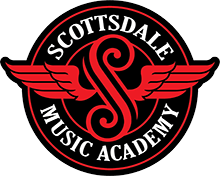When a person starts to take guitar lessons, the instructors usually start teaching with standard tuning. That’s the standard E-A-D-G-B-E (large to small strings) tuning for the six strings on a guitar.
Many guitarists are quite happy to stick with standard tuning for the rest of their playing days. However, other guitarists are more inquisitive about learning alternate tunings. If you’ve not heard of how alternate tunings work, then keep reading for a brief introduction to making your guitar sound like another instrument.
What is Alternate Tuning?
Tuning a guitar with alternate tuning helps to make the strings sound different when playing a collection of notes for chords. Some alternate tunings only change one string’s tuning from the standard format. This is seen in a popular alternate tuning of Drop D. By changing the tuning slightly, the guitarist can harness new sounds (and new melodies) to play. It can feel like walking into Alice in Wonderland’s world, where everything is not always as it seems, but it all seems to work somehow.
There are one-string alternate tunings, and then there are multiple string alternate tunings, like Open G tuning that change two strings. These additions to the standard tuning format can unlock musical ideas in players across the musical spectrum.
Favorite alternate tuning
Part of the reason why the Grunge era of the early 1990s shook the rock world was because the guitar sounds that were coming from Seattle were louder and heavier than what was being heard at the time. Many bands that followed in the wake of the Grunge era were using Open G and Drop D tunings to create a monster rock guitar sound.
The Drop D tuning happens a player tunes the low E string down a step to the D note. Combined with the open A note on the fifth string, this now gives a guitaris all six strings to play a loud D chord. Try the Drop D tuning by by turning your E string tuning peg lower to match the 4th (d) string sound. Once it’s in Drop D, you can even strum the guitar with a barre chord to give it that extra heavy sound.
Here’s a great guitar tuning chart to figure out some alternate tunings to play some of your favorite songs. Maybe you’ve tried to learn popular online songs and you just can’t get it right. That’s likely due to a different type of alternate tuning.
Playing Challenges
Many new guitarists taking guitar lessons in Scottsdale might find that playing a guitar with normal tuning is difficult already. But when you start to mess with the tunings, it forces a guitarist to re-learn the basic chords they once knew in standard tuning to the new tuning.
Our bit of advice to students at Scottsdale Music Academy is to try to learn one alternate tuning at a time. See how your fingers move with this alternate tuning, and check if the sounds you’re hearing work with the type of music you’re seeking to create. Sometimes, just a slight alternate tuning can enrich a guitarist’s playing ability.
If you have extra time this autumn, get in touch with the music pros at Scottsdale Music Academy. We’ll help you learn alternate tunings for guitar, and apply them to the type of music you like to play most. Give us a call at (602) 751-3537 to check our our first lesson free offer, and let’s get rockin’ together!

